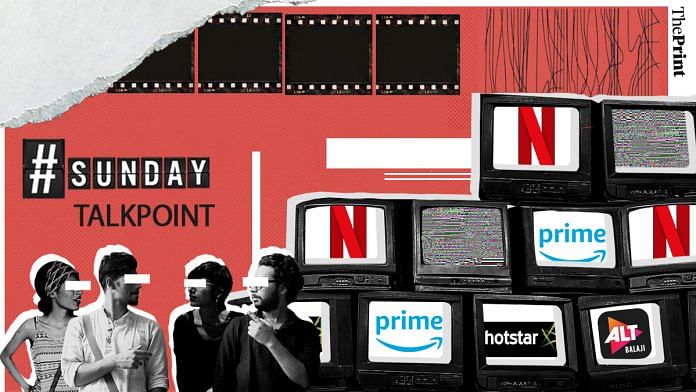Netflix has reported a miss in subscriber growth in the third quarter and also projects fewer new customers in the fourth quarter than last year. In India, Netflix faces competition from cheaper streaming platforms such as Amazon Prime Video, Hotstar, ALTBalaji and Zee5. A report by FICCI-EY said, “Indians spend 30 per cent of their phone time and over 70 per cent of their mobile data on entertainment.” To fight competition, Netflix has launched a cheaper mobile-only monthly plan of Rs 199.
ThePrint asks: Can Netflix India counter the challenge from cheaper Amazon Prime, Hotstar, ALTBalaji?
Netflix has a lot to offer but platforms like Hotstar cater to bigger audience with Indian daily soaps & sports
Taran Deol
Journalist, ThePrint
Netflix has a lot to offer but platforms like Hotstar cater to a bigger audience with Indian daily soaps & sports.
Netflix came to India two years ago and became a phenomenon unto itself. It created a link with the West, allowing Indians to stream new shows simultaneously. They didn’t have to resort to downloading them from dodgy websites, or worse, wait for them to come on Indian cable. But since Netflix’s launch, India has also witnessed its own, cheaper streaming platforms like Hotstar, ALTBalaji, Zee5 along with Amazon’s Prime Video establish themselves as credible alternatives.
All these streaming platforms have produced hit TV shows and movies. But no single streaming platform can ever have all the top shows. While Netflix enjoyed its novelty for a limited time, Amazon Prime Video and Hotstar are fast becoming strong contenders with shows, movies, and series that are just as good.
Hotstar, given its digital rights to HBO, brings shows like Game of Thrones and Chernobyl to viewers along with Indian daily soaps that have a large user base in the country. Besides shows and movies, Hotstar also serves as a great platform for sports enthusiasts with exclusive rights to stream cricket matches. And we all know what cricket means to Indians.
Netflix is definitely facing a challenge from its cheaper clones and while it does have a lot to offer, the question remains – does it have what majority of Indians really want to watch?
Amazon Prime and ALTBalaji are cheaper but viewers now want content satisfaction, which Netflix provides
Bismee Taskin
Journalist, ThePrint
Amazon Prime and ALTBalaji are cheaper but viewers now want content satisfaction, which Netflix provides.
The challenge here is more of content than the subscription amount because the difference does not affect loyal viewership. Netizens become avid followers of shows and movies on a platform that consistently produces desirable, attractive, balanced content. This is where Netflix gets an upper hand, with all its fresh content it creates. Also, contents on Netflix are available in disparate genres – mini-series, documentaries, biographies, stand-up comic acts, etc.
But its original shows like Black Mirror, The Innocents, etc. that make Netflix’s content base look instantly superior. Moreover, Netflix has a separate sub-platform for kids to keep a regulation on its viewers, which is a mandatory clause for big networks.
Netflix’s content flow is perennial, unlike Hotstar. The platform’s subscription base increases manifold during the release of series like Game of Thrones. One could argue the same about Netflix and Sacred Games but Netflix has a specific target audience, which believes in Netflix and Chill, and just scrolling down the network’s content.
Netflix has a different yet extremely user-friendly interface that brings to you the kind of shows you like or have watched. From Roma to Manhunt: Unabomber to Lust Stories to award-winning movies, Netflix never fails to upgrade and update its content base. No doubt Amazon Prime Video and ALTBalaji are cheaper, but viewers nowadays believe more in content satisfaction. Netflix doesn’t have much of a competition from other streaming networks.
Also read: Netflix gets close to the big question: Can it survive at this rate of growth?
Netflix must tackle pricing and local content to ward off challenges from streaming platforms in India
Tarun Kant Sharma
Journalist, ThePrint
Netflix must tackle pricing and local content to ward off challenges from streaming platforms in India.
Yes, there is a challenge. Most Indians had their first interaction with an over-the-top (OTT) service through Netflix, which no doubt provides niche content but it has not gone unchallenged.
In a country where people love to watch free-to-air channels, including news, and download the latest shows and movies via Torrent, price is a big issue. The monthly subscription amount for Netflix is almost the same as those of Amazon Prime Video, Hotstar and ALTBalaji put together.
Once you take the content of the three platforms into consideration, there’s nothing much left to lose. Hotstar not only has HBO originals but provides live streaming of sports, Indian soap operas and regional movies as well; Amazon Prime Video has been giving regular hits like Mirzapur, Made in Heaven and The Family Man. Nothing sells quicker than adult content and ALTBalaji has a lot to offer in Rs 300 a year.
Another important aspect is the focus on indigenous content, in particular on non-Netflix platforms. Be it Amazon Prime Video’s Comicstaan or ALTBalaji’s Gandi Baat, you don’t have to struggle with cultural references the way you struggle with Hasan Minhaj’s stand-up acts or in a series like Easy on Netflix.
So, from reducing subscription prices to bringing local content, Netflix has a lot it needs to work upon to start catering to the masses while retaining the niche to meet the challenge in India.
Biggest threat to Netflix in India is not from other streaming platforms, but censorship
Neera Majumdar
Senior copy editor, ThePrint
Biggest threat to Netflix in India is not from other streaming platforms, but censorship.
Netflix India might have content competition occasionally from Hotstar and Amazon Prime, as well as regional streaming services like Hoichoi and ALTBalaji, but it is still ruling the streaming platform game.
In fact, though there are cheaper options, Netflix India has already declared its mobile-only subscription plan, which costs Rs 199/month, a success.
Netflix hopes the next 100 million subscribers to join its platform will be from India. As it expands, developing economies are becoming promising markets for the streaming giant. Its subscriber growth fell in the US in the third quarter because Americans are waiting for the launch of Apple TV+ and Disney+. Before that, the loss in the April-June quarter in the US was its first contraction in eight years. Which is why Netflix is counting on countries like India more than ever.
But in India right now, it’s not the other streaming channels that are a major threat to Netflix’s growth – it’s censorship. If the government starts regulating these platforms, Netflix can lose a substantial number of subscriptions, because as they say: content is king. And from Lust Stories to Sacred Games, Netflix is bringing a lot more than Sooryavansham on Sony Liv.
Also read: F.R.I.E.N.D.S turns 25: Has the popular sitcom aged well?
Netflix only needs to remain dynamic and culturally perceptive. Users won’t quit just because of price
Nandita Singh
Senior reporter, ThePrint
Netflix only needs to remain dynamic and culturally perceptive. Users won’t quit just because of price
People who can afford Amazon Prime Video, Hotstar and ALTBalaji can also go up the price point and get themselves Netflix if they want to. A majority of these streamers are young (either Gen X, millennials, or now even Gen Z) and live in urban and suburban areas, which means if you’re privileged enough to stream content, you’re not going to switch from Netflix to Amazon Prime Video just because it’s cheaper. You will, of course, if it’s better.
Netflix had the lucrative foresight of being the first to bank on a digital future – it is the Colgate of streaming platforms, with high brand recall, emerging subcultures, and memes that keep you ‘Netflix and chilling’ even if you’re watching ALTBalaji. Amazon Prime Video, ALTBalaji and Hotstar quickly realised that they need to differentiate — by bringing live sports to our drawing rooms, making content in Hindi and regional languages, or re-packaging desi to be relatable to the young, urban Indian.
If Netflix wants to challenge these platforms, it doesn’t need to become cheaper, it needs to remain dynamic and culturally perceptive. It’s how the McAloo Tikki and Gobi Manchurian continue to thrive in the country today.
By Taran Deol, journalist at ThePrint







None of these competitors can add shows like Netflix. Netflix been adding shows like no other and in lot of different languages from other parts of the world. Netflix will stand on its own much better than ball these upstarts combined.